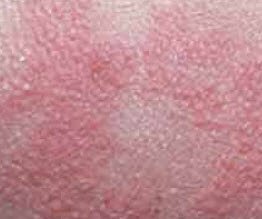Causes of Dog Warts:
There are two different possible causes of canine warts. Genetically, some dogs may have warts on the body when they are born or they may develop on any part of body when they are older. These are usually not harmful or do not cause any discomfort to the affected dog. They do not grow and are comprised of dark pigment gathered at certain points on the outer surface of the body. These resemble common human warts.

Skin Papules on Dog
A Papule is Any solid Elevation of up to 1 cm in Diameter
Other types of dog warts are called “papillomas”. These are caused by viruses of the Papovaviridae family. In dogs, this viral type of wart has three different forms:
- Mucous Membrane Papillomatosis: This is the most common form of viral canine warts; these are more frequent in young dogs. This form of canine wart mostly appears over the mucous membrane in the oral cavity, tongue, esophagus, gums, outer eyelids and the inner layers of the conjunctiva (membrane lining the eyelids). In an infected dog, the warts grow in number and usually resolve in days or weeks. Sometimes, due to chewing and swallowing, the warts may get injured, thus secondary infections may occur in the oral cavity or esophagus.
- Cutaneous Papillomas: This form resembles congenital warts, but occur more frequently in older dogs that have rough and weakened coats. Up until now, a definite relationship of this form of wart to viral infection has not been established. Keratin, which is a cutaneous protein, has been identified as being the content of these types of warts in dogs, which resembles congenital canine warts.
- Cutaneous Inverted Papillomas: This form of dog wart may occur in young as well as older dogs. They appear under the cutaneous layer (skin), over the epithelial tissues, thus are termed as epitheliomas. These mostly occur on the ventral abdomen (on the belly), with characteristics of a raised papu-nodular appearance and keratotic center.
Not always, but in a few cases, congenital as well as viral warts may develop into cancer, which is usually fatal in nature.
Diagnosis:
Though warts in dogs do not cause any damage to the body, especially those which appear over the skin and appear firm, it is better to consult a veterinarian to eliminate any chance of complications and cancer.
Oral and eye warts should be carefully diagnosed and treated. Also a biopsy should be performed (skin sample for lab testing), as research shows oral warts, eventually appear as squamous cell carcimomas in their advanced stages. A biopsy of those warts should also be done which have grown larger and which cause any stress, discomfort or pressure over the dog and its body organs. Canine warts with a cauliflower appearance and irrational growths should be considered for a biopsy.